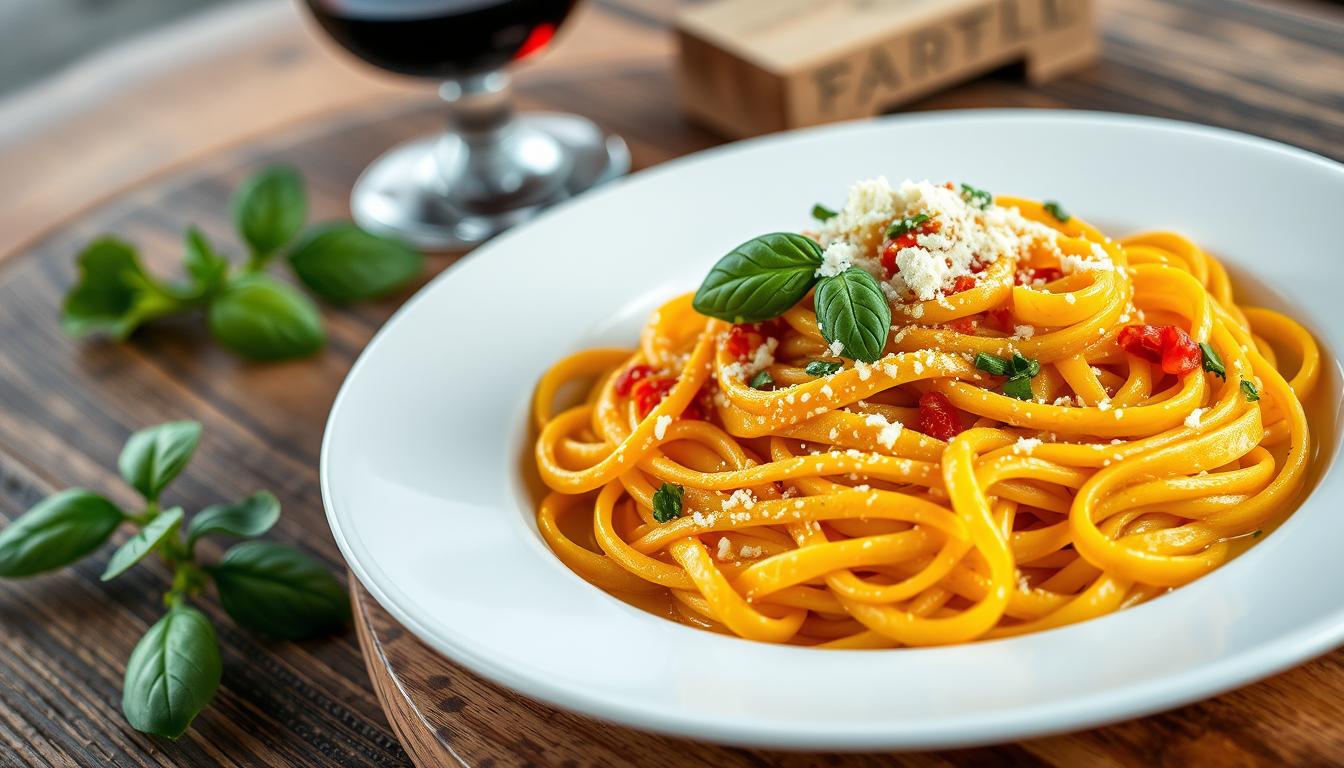We’re starting a journey into the world of Tagliolini, a beloved Italian pasta. It’s loved by food enthusiasts worldwide. Learning how to eat pasta can make our meals better, and Tagliolini is a great example. Its unique shape and texture make it a feast for the senses.
In this article, we’ll cover the best ways to enjoy Tagliolini. We’ll explore authentic recipes and flavors. Let’s discover how to make every bite a memorable experience.
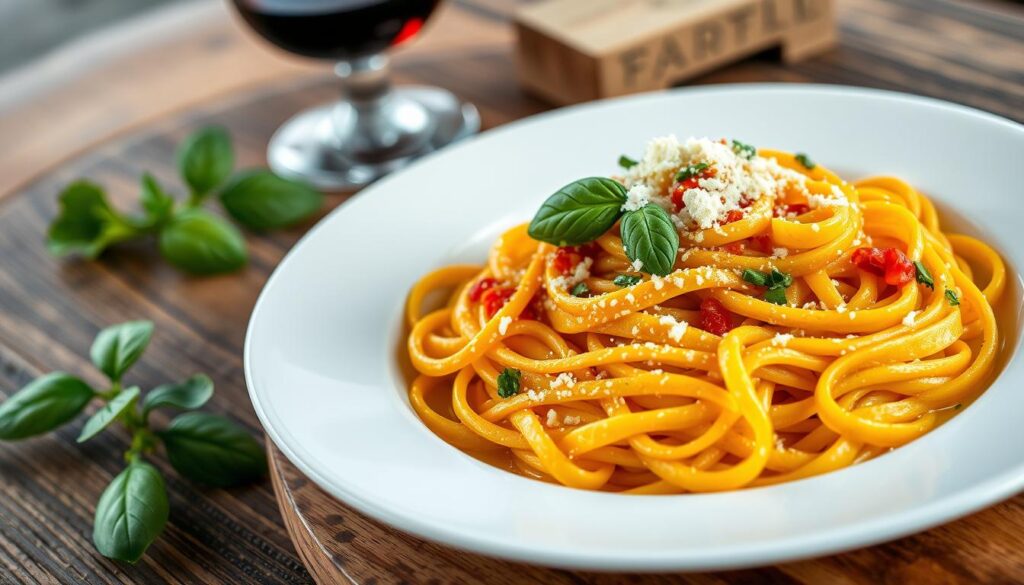
Key Takeaways
- Tagliolini offers a distinct texture that enhances the eating experience.
- Understanding proper etiquette can enrich our dining practices.
- Choosing the right sauces is essential for maximizing flavor.
- Exploring regional variations can deepen our appreciation of Tagliolini.
- We’ll learn traditional methods to prepare this delightful pasta.
Understanding Tagliolini: What Makes It Unique
Tagliolini is a standout in the world of Italian noodles. It has a long, flat shape, thinner than fettuccine but wider than spaghetti. This shape greatly affects the dish’s texture and taste.
Tagliolini is known for its simple ingredients: just flour and eggs. This simplicity lets it soak up sauce flavors well, making each bite rich. When we cook with Tagliolini, we pick sauces that match its unique qualities.
Tagliolini also holds a special place in Italian cuisine. It comes from northern Italy, especially Emilia-Romagna. Here, it’s celebrated with rich sauces that show off the region’s flavors.
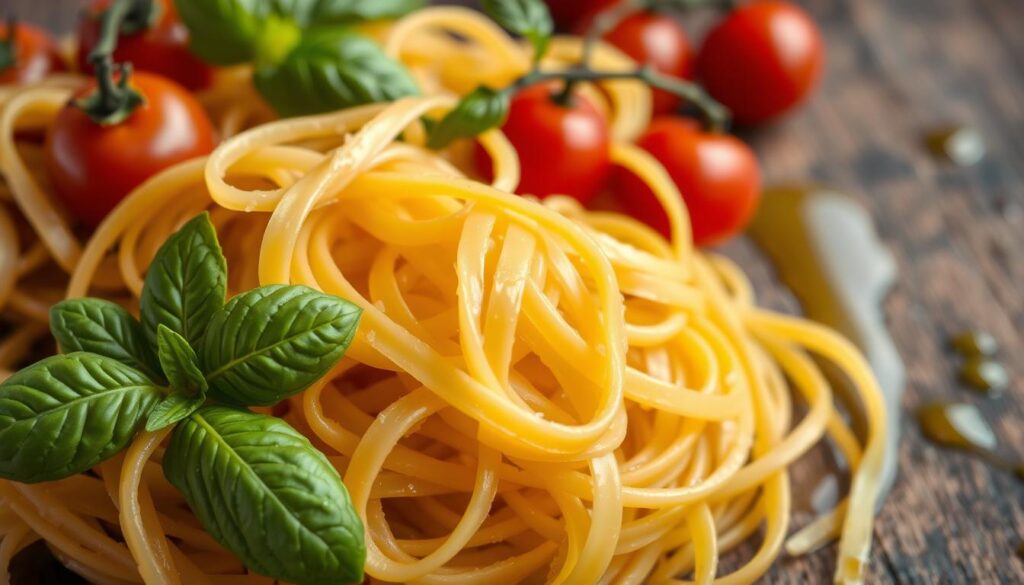
Exploring Tagliolini, we see it’s more than just a pasta. It’s a key part of Italy’s culinary history, showcasing the beauty of quality ingredients. By using Tagliolini in our cooking, we pay tribute to Italian traditions and flavors.
The Origin of Tagliolini: A Taste of Italy
The history of Tagliolini is a tasty journey through Italy’s varied food scene. It comes from Liguria and Piedmont, where it’s loved for its unique texture and flavor absorption. Exploring its origins, we see how local ingredients and traditions made Tagliolini a key part of Italian cuisine.
Tagliolini is known for its thin, flat shape, similar to other famous pasta types. It’s made with egg and flour, creating a dough that shows Italian cooks’ skill. Each region adds its own twist, making regional varieties loved worldwide.
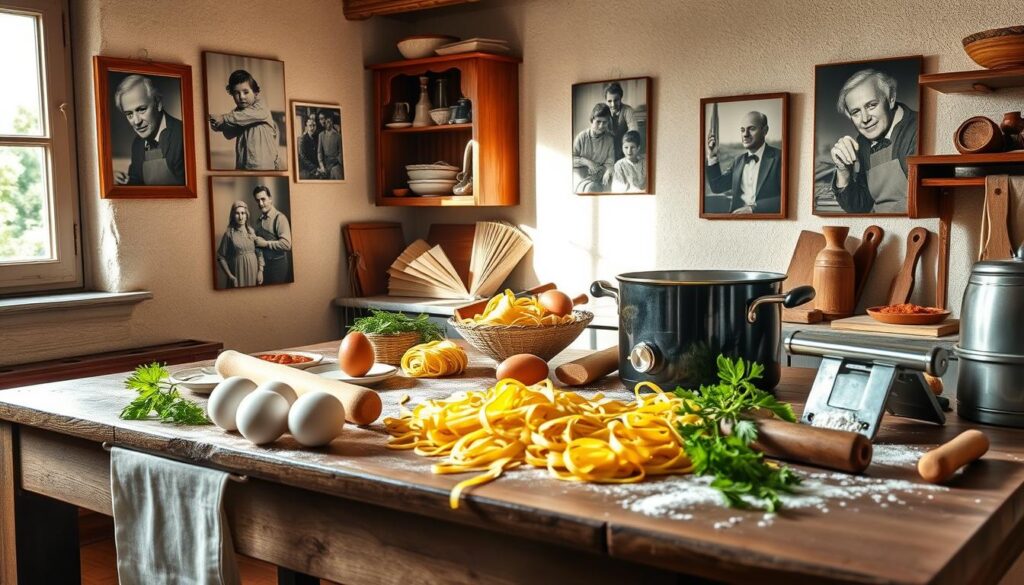
Learning about Tagliolini’s origins helps us understand its importance in Italian food. It shows the cooking traditions and cultural influences that make Italian food so rich and varied.
| Region | Characteristics | Typical Ingredients |
|---|---|---|
| Liguria | Known for its thin, delicate strands. | Eggs, durum wheat flour, olive oil. |
| Piedmont | Often made thicker and served with hearty sauces. | Eggs, soft wheat flour, local herbs. |
| Tuscany | Typically handmade, with a rustic texture. | Eggs, whole wheat flour, seasonal vegetables. |
By looking at these details, we see how Tagliolini went from a simple pasta to a beloved part of Italian and global food culture.
How to Cook Tagliolini Perfectly
Cooking Tagliolini is a rewarding experience. It brings authentic Italian flavors to your home. To cook it perfectly, start with quality ingredients and follow best practices.
- Begin by bringing a large pot of salted water to a rolling boil. The salt enhances the flavor of the pasta as it cooks.
- Add the Tagliolini to the boiling water, ensuring it has enough room to move freely.
- Stir occasionally to prevent sticking. This is a crucial step in how to cook pasta effectively.
- Cook for approximately 3-4 minutes, or according to package instructions, until the pasta is al dente. We recommend tasting it slightly before the suggested cooking time to achieve the perfect texture.
- Once ready, carefully drain the Tagliolini using a colander. Avoid rinsing the pasta, as this washes away the starch that helps sauce adhere.
Mistakes can lead to overcooked or undercooked pasta. Pay attention to the timing, and always taste the Tagliolini for doneness. Consistency in cooking practices will ensure that we enjoy perfect pasta cooking every time.
By following these steps and adhering to the guidelines of how to cook Tagliolini perfectly, we can create a delightful dining experience that echoes the essence of Italian cuisine.
Proper Ways to Prepare Tagliolini Dishes
Preparing Tagliolini requires knowing both old and new ways. Freshness is crucial for making tasty Tagliolini recipes. Using top-notch ingredients adds flavor, giving our dishes a true Italian taste.
First, we start with fresh egg Tagliolini. It’s made from just flour and eggs. The dough needs to be kneaded until it’s smooth and then rested. This makes the pasta tender.
After resting, we roll out the dough into thin sheets. Cutting it into long, thin strands is key. This ensures the pasta cooks evenly.
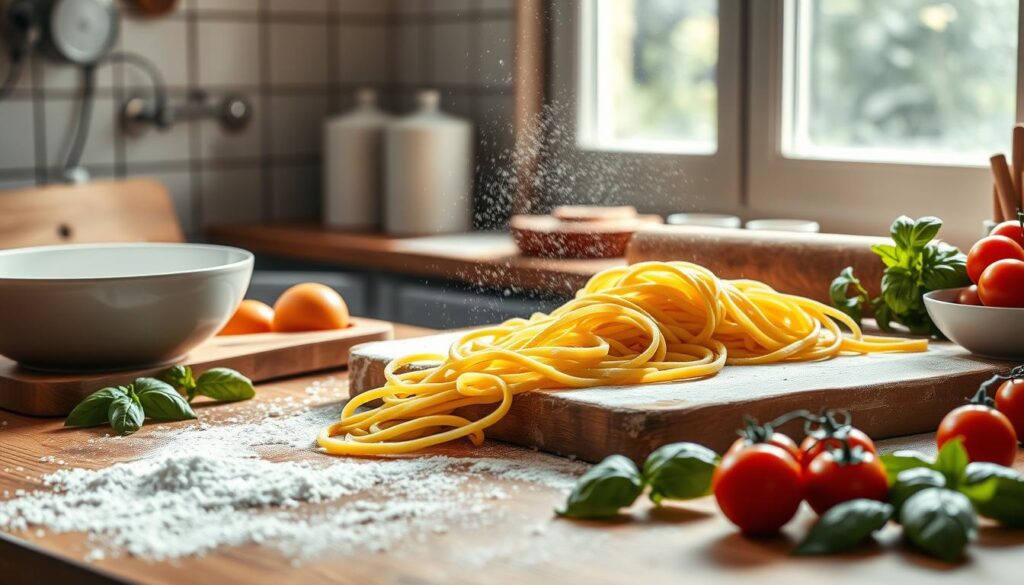
To cook, boil the pasta in salted water. This brings out its flavor. Cooking for 2-4 minutes keeps it al dente. We want to show how to serve Tagliolini in a way that honors its roots and appeals to today’s tastes.
Adding seasonal ingredients makes a dish special. Fresh veggies, herbs, and proteins add excitement to any Tagliolini recipe. A quick sauté of garlic and fresh produce with our pasta makes a meal that wows everyone.
Finally, how we present our Tagliolini matters. A simple dish can be made special with a drizzle of olive oil, some cheese, or herbs. Knowing how to serve Tagliolini with flair makes the meal unforgettable.
Best Sauces to Pair with Tagliolini
Choosing the right sauce can truly elevate our experience with Tagliolini. We’ll explore classic and innovative pasta sauces that complement this delicate pasta beautifully.
Classic Italian Sauces for Tagliolini
Classic Italian sauces are perfect for our Tagliolini dishes. Here are some timeless favorites:
- Pesto: A vibrant blend of basil, garlic, pine nuts, and Parmesan, this sauce adds freshness and a delightful nuttiness.
- Marinara: Rich in tomatoes and herbs, marinara enhances Tagliolini with its robust flavors.
- Carbonara: A creamy mixture of eggs, cheese, bacon, and pepper creates a sumptuous coating for our pasta.
Modern Twists on Traditional Sauces
We can also experiment with innovative pasta sauces. These bring contemporary flavors to traditional options. Here are some creative ideas to consider:
- Avocado Cream Sauce: A creamy blend derived from avocados, garlic, and lemon zest offers a fresh and healthy alternative.
- Spicy Roasted Red Pepper Sauce: This sauce combines roasted peppers with chili flakes and cream for a refreshing kick.
- Brown Butter Sage Sauce: Nutty brown butter paired with crisp sage leaves provides a fragrant and savory twist.
These options showcase the versatility and deliciousness of combining classic and modern flavors for the best sauce for Tagliolini.
| Sauce Type | Main Ingredients | Flavor Profile |
|---|---|---|
| Pesto | Basil, garlic, pine nuts, Parmesan | Fresh, nutty |
| Marinara | Tomatoes, garlic, herbs | Robust, savory |
| Carbonara | Eggs, cheese, bacon, pepper | Rich, creamy |
| Avocado Cream Sauce | Avocados, lemon, garlic | Fresh, creamy |
| Spicy Roasted Red Pepper Sauce | Red peppers, chili, cream | Spicy, sweet |
| Brown Butter Sage Sauce | Brown butter, sage | Nutty, fragrant |
Tagliolini Dining Etiquette: Eating Like an Italian
Learning about Tagliolini dining etiquette makes our meals more enjoyable. It lets us appreciate this tasty dish in a way that honors its Italian origins. Knowing the best utensils and when to serve it can greatly enhance our experience.
Using the Right Utensils for Tagliolini
To eat Tagliolini correctly, we usually use a fork. Sometimes, a spoon is helpful for twirling the long strands. A fork makes twirling the pasta elegant and mess-free, showing respect for pasta dining etiquette. Here’s a quick guide to help you:
- Always use a fork: This is the main tool, making it easy to grab the pasta.
- Consider a spoon for assistance: If twirling with a fork is hard, a spoon can help without ruining the experience.
- Avoid cutting the pasta: Cutting is not preferred in Italian culture, as it messes with the pasta’s look and feel.
When to Serve Tagliolini in a Meal
Knowing when to serve Tagliolini is as important as how to eat it. It fits well into different parts of our meals:
| Meal Stage | Ideal Time to Serve |
|---|---|
| Appetizer | Lightly dressed Tagliolini makes a great starter. |
| Main Course | Rich sauces like Bolognese go well with Tagliolini for the main course. |
| Side Dish | Tagliolini adds to the meal when served with meat or fish. |
Flavor Combinations That Enhance Tagliolini
Exploring Tagliolini flavor combinations opens up a world of culinary creativity. We can enhance Tagliolini with simple techniques, fresh ingredients, and a blend of flavors. This journey will take us through vibrant vegetarian options and sumptuous meat-based combinations for every taste.
Vegetarian Options: Fresh Ingredients
When making vegetarian pasta recipes, fresh ingredients are key. Seasonal vegetables, herbs, and organic products add vibrant flavors to Tagliolini. Some great combinations include:
- Cherry tomatoes and basil, with a hint of garlic.
- Seasonal greens like spinach or arugula, adding a peppery note.
- Roasted bell peppers with balsamic vinegar for depth.
- Mushrooms sautéed in olive oil, adding earthy richness.
Meat-Based Combinations for Tagliolini
For those who prefer heartier options, meat pasta dishes offer a great contrast to Tagliolini’s delicate nature. Enhancing Tagliolini with robust flavors leads to delightful pairings, such as:
- Shredded chicken in creamy Alfredo sauce.
- Ground beef or sausage with aromatic herbs and spices.
- Seafood, like shrimp or scallops, in zesty lemon sauce.
- Pork ragu, simmered slowly for rich, layered flavors.
Regional Variations of Tagliolini in Italy
Exploring regional Tagliolini in Italy reveals a world of flavors and traditions. Each region adds its own twist to this beloved pasta. This shows how Italian pasta variations celebrate local ingredients and cooking styles.
In northern regions like Emilia-Romagna, Tagliolini is often paired with rich sauces. These sauces include cream, cheese, and local meats. Coastal areas use saffron and seafood, showing off the sea’s fresh offerings.
In Tuscany, Tagliolini is mixed with wild mushrooms from the nearby woods. This highlights the region’s earthy forests and culinary heritage.
The south, like Campania, takes a different path. It uses tomato-based sauces with a zesty touch. Fresh vegetables and olives add a burst of flavor, celebrating the area’s sunny climate.
Tagliolini’s versatility across Italy is fascinating. It lets each region express its identity through food. Each dish tells a story of culture and flavor, showing the key role of regional Tagliolini in Italian cuisine.
How to Eat Tagliolini: Step-by-Step Guide
Eating Tagliolini is more than just tasting its flavors. It’s a cultural experience that involves specific ways of eating pasta. By following these easy steps, we can enjoy Tagliolini to the fullest.
- Start by using a fork to pick up a small portion of Tagliolini. Too much pasta can lead to a messy experience.
- Instead of stabbing the pasta, twirl it gently on the plate. This technique allows the noodles to wrap around the fork without breaking them.
- As we twirl, make sure to incorporate the sauce, as this enhances flavor and texture.
- Bring the twirled pasta to our mouth. This method ensures a delightful bite full of flavor.
- Remind ourselves to chew slowly. Enjoying Tagliolini is about relishing each mouthful.
This method not only respects the traditions of Italian cuisine but also allows us to appreciate the art of eating. By practicing these eating techniques for pasta, we elevate our experience and truly savor every dish. Remember, enjoying Tagliolini is about taking the time to relish the flavors while immersed in good company.
| Step | Description |
|---|---|
| 1 | Use fork to select a small portion |
| 2 | Twirl gently on the plate |
| 3 | Incorporate the sauce with the twirl |
| 4 | Bring twirled pasta to mouth |
| 5 | Chew slowly to enjoy |
Creating a Memorable Tagliolini Dining Experience
To enjoy a Tagliolini meal, we need to create a welcoming atmosphere. This means setting up our dining area with Italian flair. We should think about the layout, decor, and wine pairings that will make our meal special.
Setting the Table for Italian Cuisine
An authentic Italian table needs careful planning. Choose a tablecloth that reminds you of Italy’s rustic charm. Add cloth napkins, elegant dishes, and simple centerpieces like fresh herbs or flowers to enhance the mood. Here are some tips:
- Use warm, earthy colors for a cozy feel.
- Choose simple yet beautiful dishes that show Italian culture.
- Use small plates for sharing, which is a big part of Italian dining.
Choosing the Right Wine with Tagliolini
Choosing the right wine is key. The right wine can make our Tagliolini dishes even more delicious. Here are some classic pairings:
| Tagliolini Dish | Recommended Wine |
|---|---|
| Tagliolini al Limone | Sauvignon Blanc |
| Tagliolini with Truffle Sauce | Barolo |
| Tagliolini with Bolognese Sauce | Chianti |
| Tagliolini with Pesto Sauce | Vermentino |
By adding these touches, we can make our Tagliolini meal unforgettable. It brings Italy to our table and delights our guests with every bite and sip.
Exploring Tagliolini Recipes from Regional Italian Cuisine
Italy’s food scene is rich and varied, with Tagliolini playing a big role. Each area has its own special Tagliolini dishes, using local ingredients and cooking styles. Let’s explore different parts of Italy, finding true Italian Tagliolini recipes that show off their roots.
| Region | Tagliolini Recipe | Main Ingredients |
|---|---|---|
| Tuscany | Tagliolini al Tartufo | Black truffles, butter, Parmesan cheese |
| Emilia-Romagna | Tagliolini al Ragu | Ground meat, tomato sauce, onion, carrot |
| Lazio | Tagliolini Cacio e Pepe | Pecorino Romano cheese, black pepper |
| Campania | Tagliolini alla Puttanesca | Tomatoes, olives, capers, garlic |
These tagliolini recipes show the wide range of tastes you can get with this pasta. We suggest trying these Italian Tagliolini dishes. They’re a great way to dive into Italy’s regional flavors and enjoy Tagliolini’s unique taste and texture.
Conclusion
In this Tagliolini summary, we’ve explored its history, preparation, and enjoyment. We’ve seen how Tagliolini’s delicate texture and versatility make it a favorite in Italian cuisine. Enjoying Tagliolini is more than just eating; it’s about the experience and culture it brings.
We’ve learned about the key role of authentic Italian cuisine and its ingredients. Each part adds to the rich flavors found in traditional dishes. We’ve discovered the variety of flavors Tagliolini can bring, from classic sauces to unique regional dishes.
Reflecting on our journey with Tagliolini, we encourage everyone to keep exploring and enjoying it. Let’s cherish the time spent together, sharing stories and delicious meals. Next time we eat, let’s remember the joy of enjoying Tagliolini and the traditions it represents.
FAQ
How do we properly eat tagliolini like Italians do?
To eat tagliolini like an Italian, use a fork and sometimes a spoon. Twirl the pasta gently onto your fork. This way, you can enjoy the dish’s full flavor without breaking the strands.
What is the best way to enjoy tagliolini?
Enjoying tagliolini means savoring each bite slowly. Let the sauce and pasta mix on your tongue. Serving it as a first course in an Italian meal is also a great way to enjoy it.
Are there any etiquette tips for dining on tagliolini?
Yes, there are etiquette tips. Avoid slurping and making loud noises. Keep your elbows off the table and finish all sauce. Using the right utensils also makes dining better.
What should we do if the tagliolini is too slippery to eat?
If it’s too slippery, use a spoon to twirl. Place the spoon behind the pasta for support as you twirl it onto your fork.
Can we eat tagliolini with our hands?
In formal settings, it’s best not to eat tagliolini with your hands. But in casual places, respect local customs and norms.
Should we drink wine when eating tagliolini?
Yes, definitely! The right wine can make your meal better. A light white or a robust red wine can bring out the pasta and sauce’s flavors.
Is there a specific way to serve tagliolini in a meal?
Serve tagliolini as a first course before the main dish. Give your guests enough to enjoy its flavors fully before moving to the next course.

